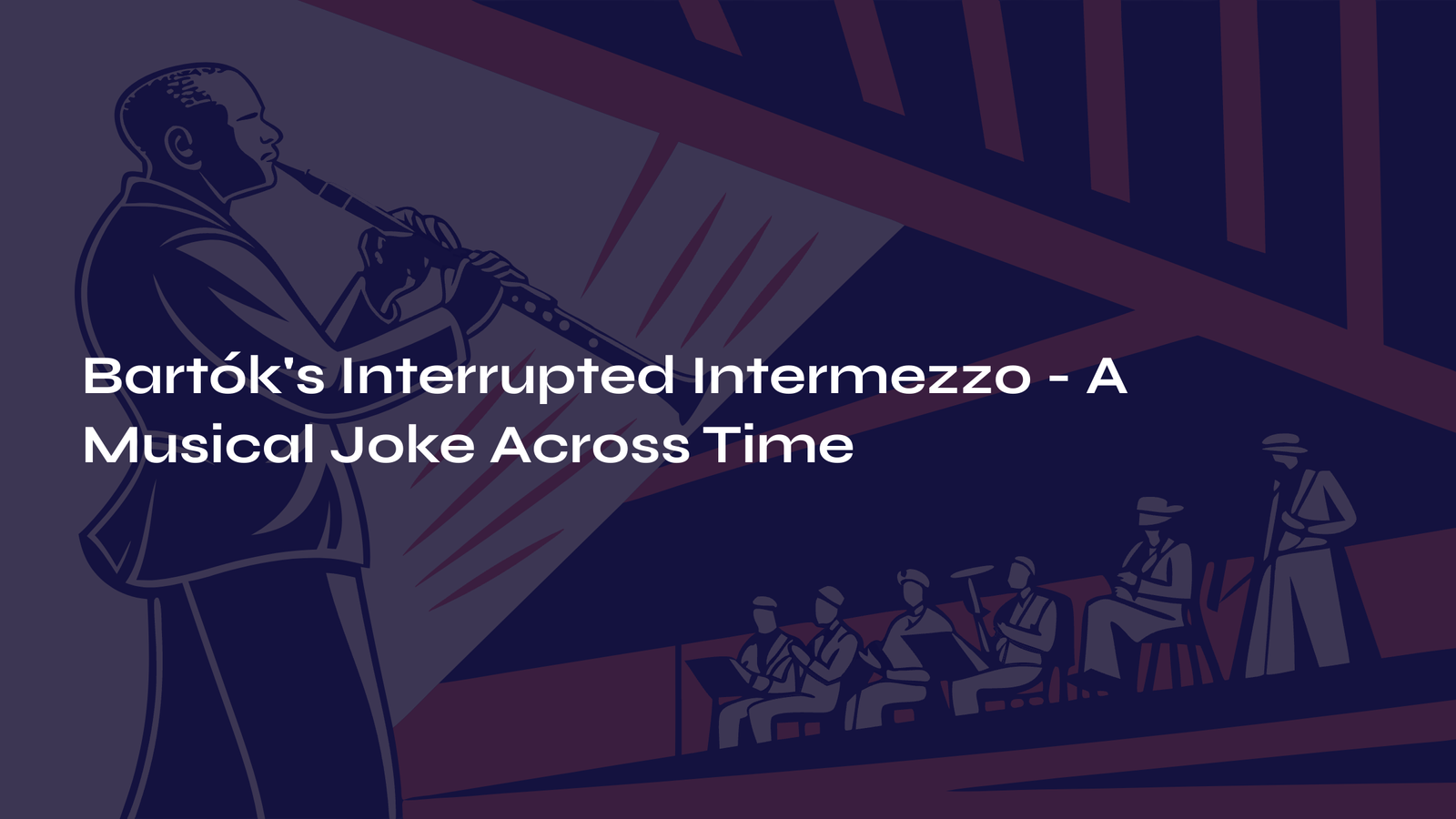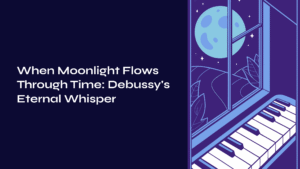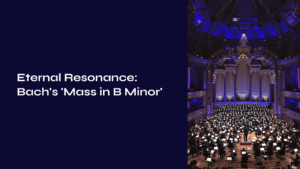Table of Contents
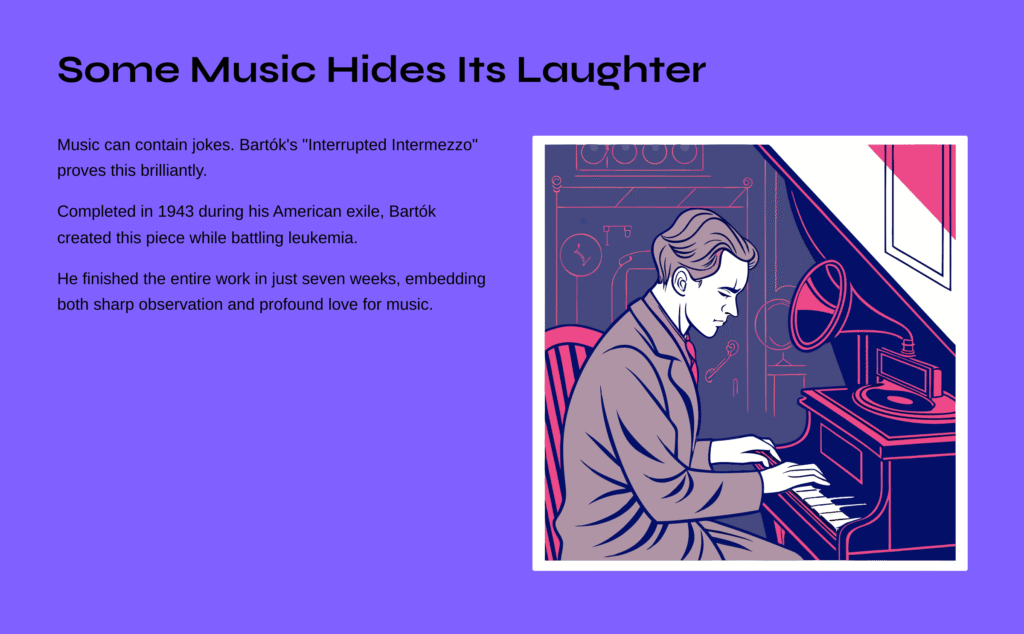
Some Music Hides Its Laughter
Do you remember the moment you first realized that music could contain jokes? I had such an experience while listening to Bartók’s “Interrupted Intermezzo.” On the surface, it appears to be a serious movement of an orchestral work, yet hidden within lies the composer’s mischievous smile. Like someone suddenly bringing up an absurd topic in the middle of a dull conversation, instantly capturing everyone’s attention.
In 1943, while battling leukemia in his American exile, Bartók completed this work in just seven weeks. The piece contained something beyond mere music—it was both a sharp observation of his times and a profound love for music itself.
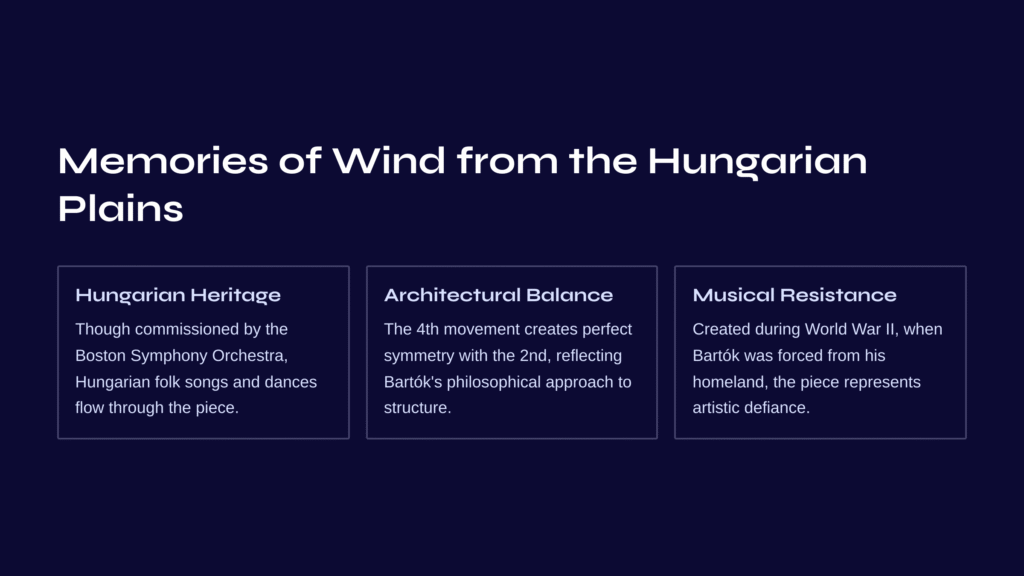
Memories of Wind from the Hungarian Plains
When Bartók wrote this piece, several years had passed since he left his homeland. While the entire Concerto for Orchestra was commissioned by the Boston Symphony Orchestra, what flows through it remains the folk songs and dances of the Hungarian plains.
The 4th movement, “Interrupted Intermezzo,” occupies a special position within the five-movement structure. The 2nd and 4th movements create symmetry with each other, like the left and right wings of a grand architectural structure maintaining perfect balance. Bartók favored such symmetrical structures—it was a philosophy embedded in his musical worldview.
The historical context of this movement’s creation is equally important. During the height of World War II, when all of Europe was engulfed in the turmoil of war, many artists were forced to leave their homelands. Bartók was among them. Yet instead of despair, he chose musical resistance.
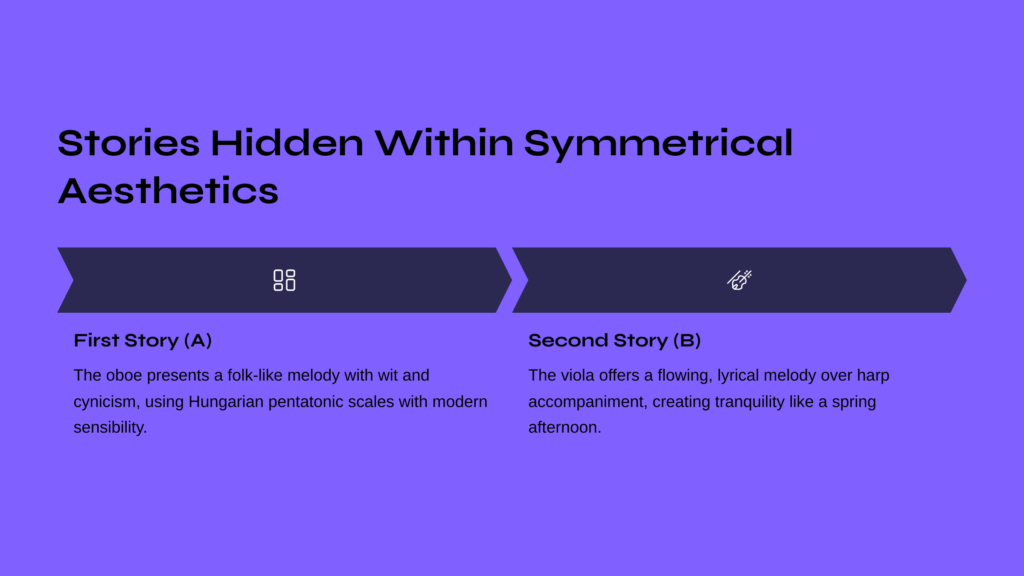
Stories Hidden Within Symmetrical Aesthetics
The structure of the “Interrupted Intermezzo” is truly remarkable—a perfect arch form following the pattern ABCBA, like viewing the blueprint of a bridge.
In the first story (A section), the oboe takes center stage. Though folk-like in character, the melody brims with wit and carries a slightly cynical smile. While showcasing the characteristics of Hungarian pentatonic scales, it reveals Bartók’s unique modern sensibility. It feels as if someone is reminiscing about old homeland dances while muttering, “How much the world has changed.”
The second story (B section) creates an entirely different atmosphere. Above the gentle accompaniment of the harp, the viola presents a flowing, lyrical melody. Listening to this section brings a tranquility reminiscent of a warm spring afternoon, watching willows sway by a riverside. The pentatonic motif expands diatonically, gently caressing the soul.
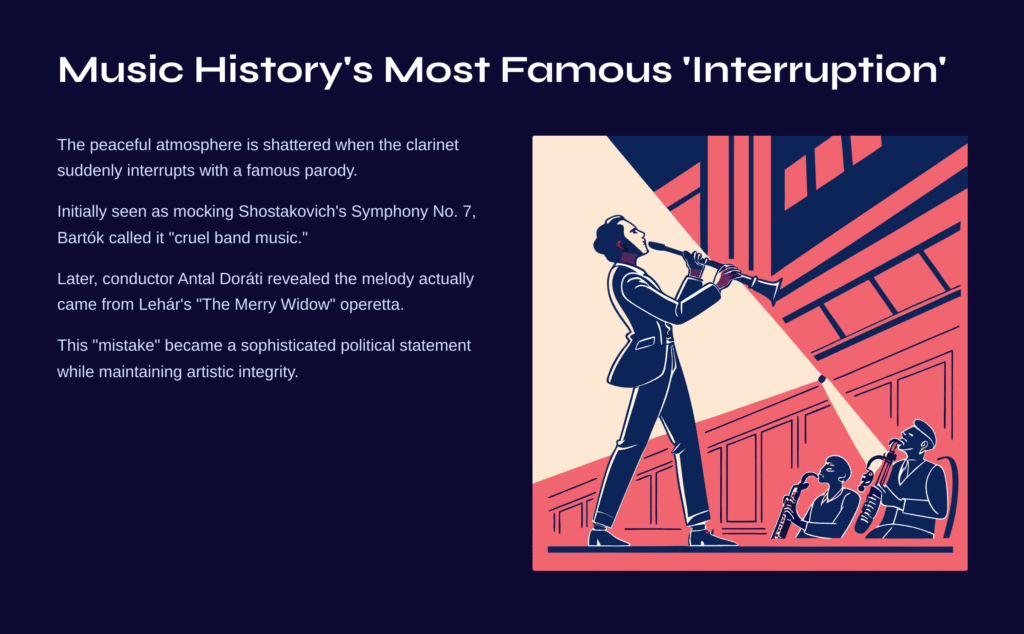
Music History’s Most Famous ‘Interruption’
However, this peaceful atmosphere doesn’t last long. In the third story (C section), the clarinet suddenly appears and ‘interrupts’ everything. The melody played here is the famous parody.
Initially, it was known as a parody of Shostakovich’s Symphony No. 7 “Leningrad.” Bartók called it “cruel band music,” expressing his critical view of Shostakovich’s music, which was excessively praised in America at the time. But what’s more intriguing comes next.
Until conductor Antal Doráti pointed it out, Bartók himself didn’t know that the melody originally came from Franz Lehár’s operetta “The Merry Widow.” It turned out that Shostakovich had also borrowed Lehár’s melody. This anecdote became one of music history’s most amusing “mistakes.”
This ‘interruption’ carries meaning beyond mere musical jest. It’s a sophisticated combination of Bartók’s personal experience of having to leave his homeland due to war and his sharp criticism of the contemporary musical situation. It’s a political statement through music while maintaining complete artistic integrity.
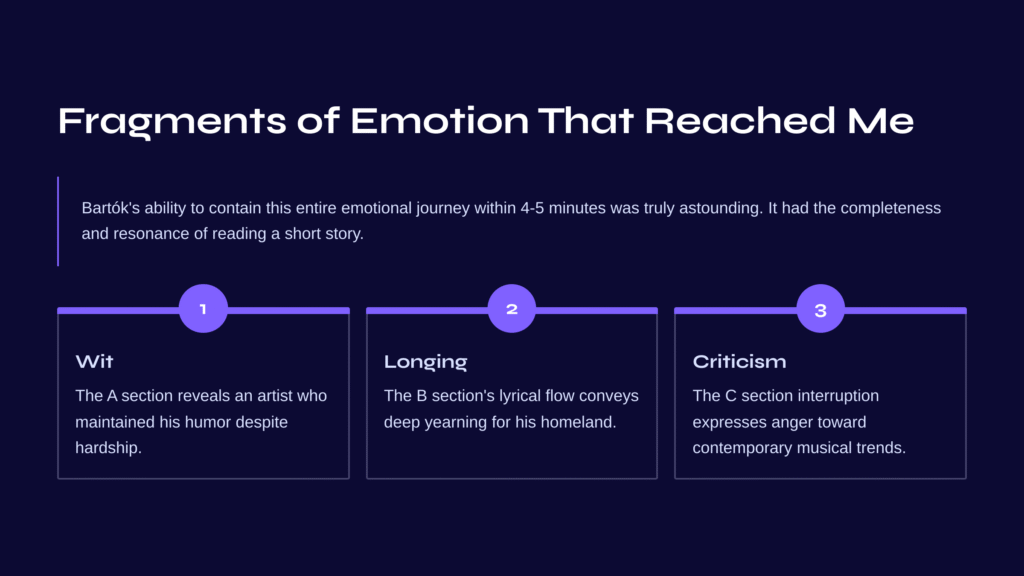
Fragments of Emotion That Reached Me
When I first properly listened to this piece, I could feel Bartók’s complex state of mind in its entirety. The witty melody of the A section revealed an artist who hadn’t lost his sense of humor, while the lyrical flow of the B section conveyed longing for his homeland.
The sudden interruption of the C section conveyed anger and criticism toward reality. I could almost hear Bartók’s voice saying, “What is this? Do you call this music?” But in the returning B’ and A’ sections, there was a sense of reaffirming his musical beliefs: “Nevertheless, real music is like this.”
Bartók’s ability to contain this entire emotional journey within 4-5 minutes was truly astounding. It had the completeness and resonance of reading a short story.

Small Secrets for Deeper Listening
Here are a few points to make your appreciation of this piece more enjoyable:
First, focus on the instrumental colors of each section. The sharp yet warm tone of the oboe, the profound lyricism of the viola, the comical parody of the clarinet—Bartók truly understood and utilized each instrument’s characteristics masterfully.
Second, listen while being conscious of the symmetrical structure. Compare what changes occur when the A section returns and when the B section is recapitulated. It’s not mere repetition but contains subtle variations and development.
Third, enjoy Bartók’s sense of humor in the parody section. Imagine a cheerful operetta melody suddenly appearing in a serious classical concert—you’ll understand the audience’s bewilderment and laughter from that time.
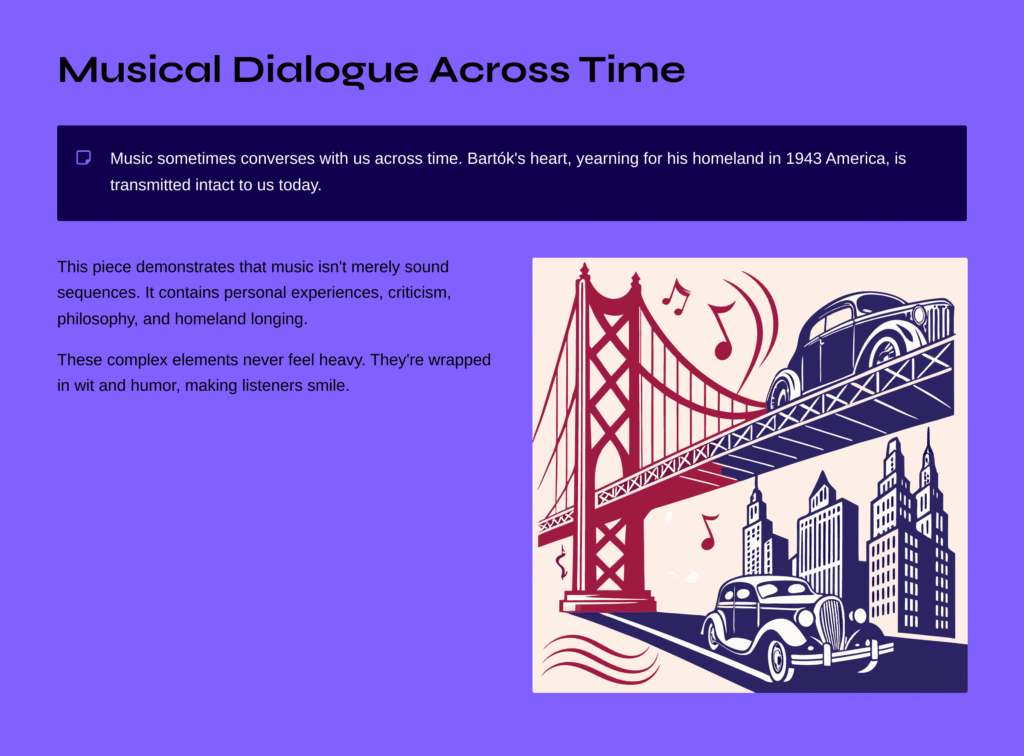
Musical Dialogue Across Time
Bartók’s “Interrupted Intermezzo” is a perfect example showing that music isn’t merely a sequence of sounds. It contains the composer’s personal experiences, criticism of contemporary situations, philosophy about music, and longing for his homeland—all melted together.
What’s most impressive is that all these complex elements never feel heavy. Rather, they’re wrapped in wit and humor, making listeners smile. Perhaps this is the leisure of a true artist.
Music sometimes converses with us across time. Just as Bartók’s heart, yearning for his homeland in 1943 America, is transmitted intact to us in 2025. The sincerity contained in his musical jokes continues to touch our hearts across the ages.

Next Destination: Grieg’s Piano Concerto
After concluding this witty musical journey with Bartók, how about departing for the lyrical melodies of Northern Europe? Grieg’s Piano Concerto in A minor, 1st movement, awaits us with entirely different charms.
If Bartók skillfully combined modern sensibility with ethnic identity, Grieg sublimated Norwegian nature and folk songs through Romantic idiom. Particularly, the famous opening of the first movement boasts an intensity that’s impossible to forget once heard. The emotional dialogue between piano and orchestra unfolds a musical landscape where the grandeur of fjords mingles with the familiarity of folk melodies.
The transition from Bartók’s intellectual and sophisticated humor to Grieg’s direct and emotional lyricism—isn’t this also part of the special charm that classical music’s journey offers?
